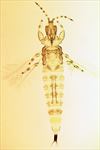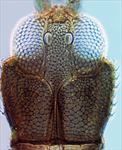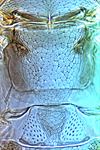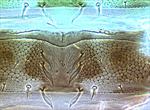
Female

Antenna

Antennal segments III–V

Head

Mesonotum, metanotum & pelta

Tergite III

Female segments IX–X (tube)

Fore wing
Both sexes fully winged. Body largely brown, but abdominal segments VIII–IX and basal half of tube yellow; tarsi yellow, mid and hind tibiae yellow at base and apex; antennal segments III–V yellow in basal half but brown distally, VI yellow; fore wing pale with long thin median brown line. Antennae 8-segmented; segments III–VI constricted to apical neck, III–IV with three stout sense cones; VIII closely joined to VII. Head reticulate, much broader across cheeks than across eyes; cheeks with prominent tubercles; eyes large; postocular setae small, capitate, posterior to inner margin of eye; maxillary stylets retracted to eyes, close together medially. Pronotum reticulate; five pairs of short, capitate major setae. Fore tarsus with prominent tooth; fore femora with sub-apical tubercle on inner margin. Metanotum reticulate, with more than 20 fine setae. Fore wing bent at an angle beyond sub-basal setae, narrow, parallel sided, with no duplicated cilia. Pelta quadrate, with distinctive median area of sculpture; tergites III–VII each with three pairs of flattened, sigmoid wing-retaining setae; tergite IX setae shorter than tube; anal setae considerably longer than tube.
Male smaller than female; fore femora swollen; sternite VIII with narrow transverse pore plate.
The genus Neurothrips includes six species, three from the Neotropics, one from Mexico, and two from North America. A key to these species is provided by Mound & Marullo (1996), who indicate that N. punanus Stannard from Mexico is probably only a pale form of N. magnafemoralis. This widespread species differs from N. apache in having the tube dark brown in the distal half or more; moreover the male has a single slender pore plate medially on sternite VIII.
Breeding on dead branches, and feeding on unidentified fungal hyphae.
Widespread across USA from North Dakota to New York, and California to Florida, but apparently not typical of the Western States.
PHLAEOTHRIPIDAE, PHLAEOTHRIPINAE
Neurothrips magnafemoralis (Hinds)
Acanthothrips magnafemoralis Hinds, 1902: 199
Mound LA & Marullo R (1996) The Thrips of Central and South America: An Introduction. Memoirs on Entomology, International 6: 1–488.